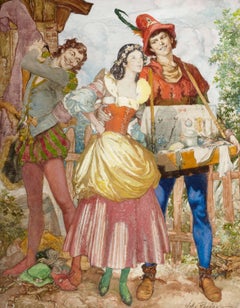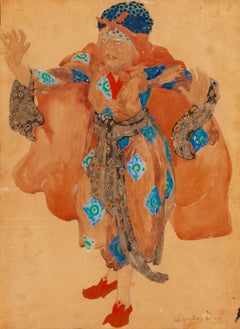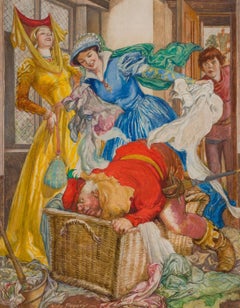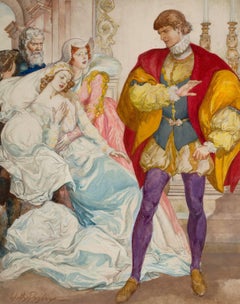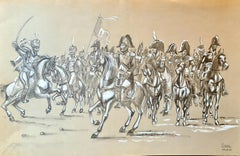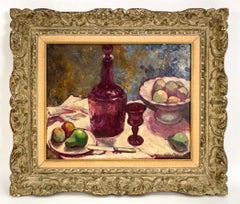Still life of fruit (with purple glass or crystal)
Hand signed lower right
Dimensions: (Frame) H 24" x W 27.5", (Canvas) H 17.25" x W 21.5"
William Andrew Pogany (born Vilmos András Pogány; August 24, 1882 – July 30, 1955) was a prolific Hungarian American illustrator of children's and other books. His contemporaries include C. Coles Phillips, Joseph Clement Coll, Edmund Dulac, Harvey Dunn, Stevan Dohanos, Walter Hunt Everett, Harry Rountree, Norman Rockwell, and N.C. Wyeth. He is best known for his pen and ink illustration drawings of myths and fables. A large portion of Pogany's work is described as Art Nouveau. Pogany's artistic style is heavily fairy-tale orientated and often feature motifs of mythical animals such as nymphs and pixies. He paid great attention to botanical details. He used dreamy and warm pastel scenes with watercolor, oil painting, and especially pen and ink cartoon work.
Willy Pogany was born in Szeged, Austria-Hungary. He studied at Budapest Technical University and in Munich and Paris. He spent his early childhood with his brothers and sisters in a large farmhouse full of chickens, ducks, geese, dogs, pigs, and horses. When he was six, his parents took him to Budapest where he would later be sent to school. He especially liked to row and to play soccer. In his spare time, he drew pictures and painted. He enjoyed painting and drawing so much he decided to be an artist. He attended Budapest Technical School for less than a year, during this time he took art classes for six weeks. He sold his first painting to a wealthy patron for $24. He spent his early twenties attending art school and would later travel to Munich, Paris, and London before coming to the United States in 1914. When Pogany went to Paris to study and paint, he was unable to secure much attention or income, was often poor and went hungry. Willi Pogany spent two years in Paris.
When he finally saved up some money from his work, he left Paris to go to London. In 1906, Arthur Rackham's Rip Van Winkle gained massive popularity, sparking a demand for artists in London. At this point Pogany was hired to provide the design For The Welsh Fairy Book by T. Fisher Unwin, including over 100 plates, illustrations, vignettes, chapter heads and tails, and initials. He also did 48 illustrations for Milly and Olly, 70 for The Adventures of a Dodo and 39 for Faust. After ten years in London, Pogany emigrated to America. Besides book illustration, pictures, mural paintings, portraits, etchings, and sculptures, Pogany became interested in theatre and designed stage settings and costumes for different shows and the Metropolitan Opera House. He eventually moved to Hollywood to serve as an art director for several film studios during the 1930s and 1940s.
In London, he crafted his quartet of masterpieces: The Rime of the Ancient Mariner (1910), Tannhauser (1911), Parsifal (1912) and Lohengrin (1913).[7] Each of these was designed completely by Pogany, from the covers and endpapers to the text written in pen and ink, pencil, wash, color and tipped-on plates.
Pogany worked as an art director on several Hollywood films, including Fashions of 1934 and Dames. He began his involvement in motion picture set design in 1924 and worked in film until the end of the 1930s. He was commissioned by John Ringling, Ettenger, Reiner and William Randolph Hearst's Wyntoon Estate, painted for the Barrymore family, Douglas Fairbanks Jr., Carole Lombard, Enrico Caruso, Miriam Hopkins, and many others.
Pogany was awarded gold medals in Budapest and Leipzig Expo as well as the London Masonic Medal, and became a Fellow of the London Royal Society of Art. The New York Society of Architects gave him a silver medal for his mural in the August Heckscher's Children's Theatre showing Cinderella, Hansel and Gretel, and Jack in the Beanstalk. He won a gold medal in 1915 at the Panama Pacific Expo for his work The ValCares and was also awarded the Hungarian Silver Blue Medal.
In 1914, Pogany's illustrations appeared on the cover of Metropolitan Magazine, Ladies Home Journal, Harper's Weekly, Hearst's Town and Country, Theatre Magazine and American Weekly.[6] In 1917 to 1921, he worked for the Metropolitan Opera designing sketches, scenery and costumes. In 1918 he illustrated a children's retelling of Homer, The Adventures of Odysseus and the Tale of Troy written by Padraic Colum.
Pogany's public art appears on walls of the John and Mable Ringling Museum of Art (formerly Ringling Mansion) in Sarasota, Florida, in New York City at the El Museo del Barrio theater (1230 Fifth Avenue), P.S. 43 Jonas Bronck in Mott Haven, and the Bernard B. Jacobs Theatre (45th Street) and in The
Strand Theatre...
